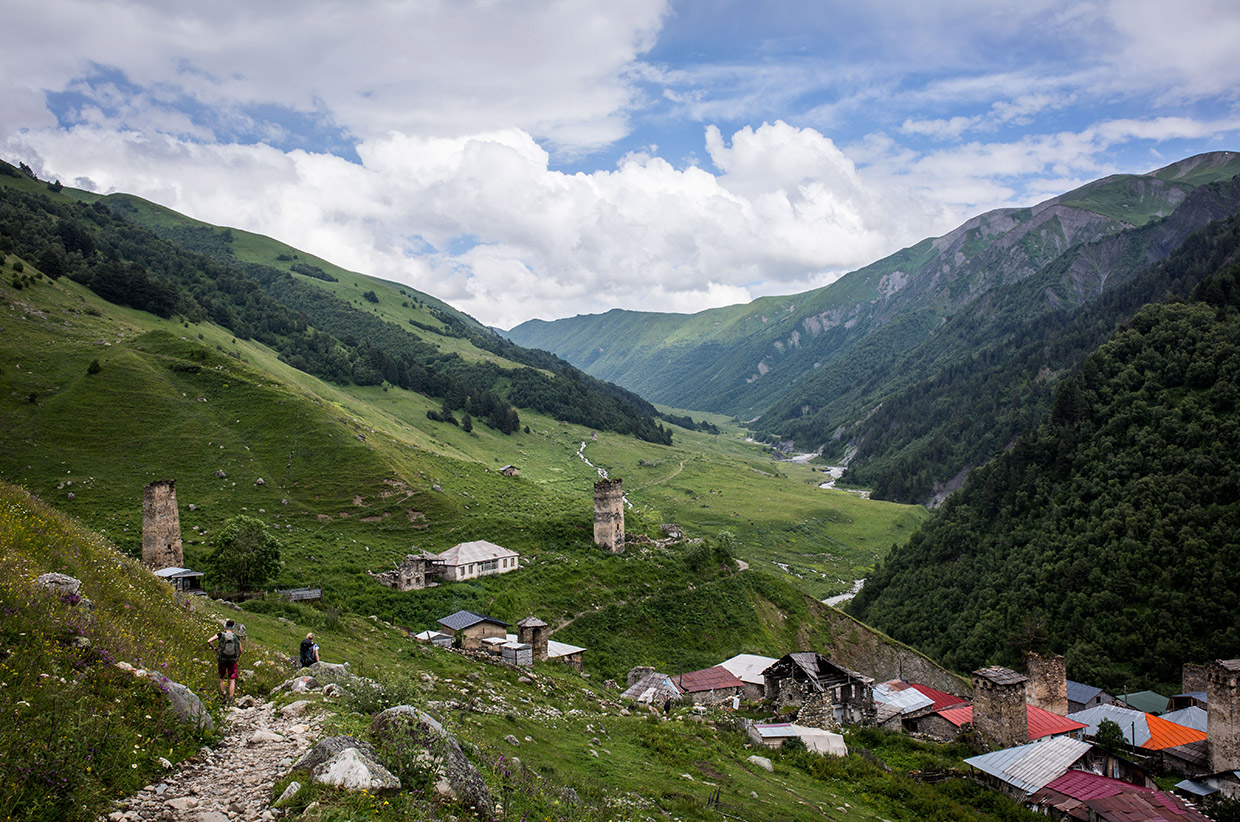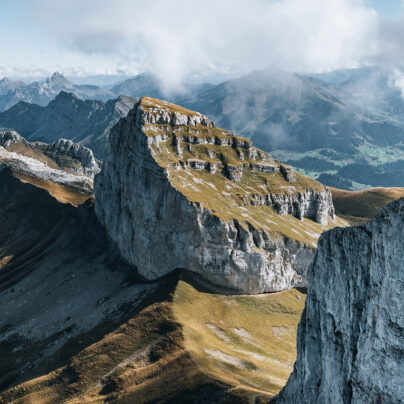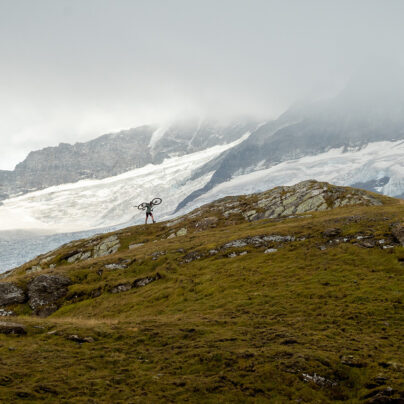My Grandmother’s Table
Hiking in Upper Svaneti
Jessie Leong
Over many heaving tables at the various guesthouses on the Georgian arm of the Transcaucasian Trail, mealtime offered a traditional depiction of rural family life, a culture that had poignant tones of nostalgia and celebration of a life surrounded by strong, proud women in their steady routine.
Food connects us. In each of our family stories, it is the meal round the table that brings the family together, symbolising the connection we share with each other and providing an opportunity for reflection on the day’s adventures. Over many heaving tables at the various guesthouses on the Georgian arm of the Transcaucasian Trail, mealtime offered a traditional depiction of rural family life, a culture that had poignant tones of nostalgia and celebration of a life surrounded by strong, proud women in their steady routine, looking after fleeting visitors, echoing the same relationship between myself and my own grandma, Pau Pau.
My grandmother would often save the weekly Chinese newspaper from the local supermarket and spread out the sheets carefully over the kitchen table as if she were laying out a linen tablecloth. The table would be pushed away from the wall for our annual visit, which meant squeezing even more family members around the kitchen table. The old newspaper hid a sticky lino tablecloth with faded illustrations of fruit. It didn’t matter that multiple dinners had rendered the surface continually sticky; maybe past meals hadn’t been cleaned properly due to absent-mindedness, or more likely our family’s denial of Pau Pau’s increasing frailty. When we made the annual visit to Pau Pau’s house at Christmas, if we wanted a glass of water, it was often best to rinse the glass first under the tap for a minute or two, as they were rarely cleaned properly, each glass discoloured with a greasy film. ‘Drink hot water!’ my Pau Pau would insist. Or better still, ‘Yum Tong!’ – a clear broth she’d boiled on the hob with bones and various bitter-smelling herbs, promoting health and well-being with each bowl.
***
In Mila’s guesthouse, located in rural Mazeri, we eyed up the discoloured water in a reused 5L plastic bottle stacked against a free-standing sink. It was an exaggeration to say that the kitchen was relatively modern by local Georgian standards; cows surrounded the ‘washing up area’, in the uneven grassy field that separated the guesthouse from the main farm building. We wondered if we could communicate enough in our broken Georgian with Mila, a tiny sparrow-like lady who wore a scarf tied at the chin and could move surprisingly fast as she scuttled to and from her kitchen in a separate outhouse. She pointed at the bottle and mimed a cup drinking action, accompanied with a sharp little nod. We looked at each other nervously, wondering whether it was apt to question the quality of the drinking water and whether it was suitable for our weaker, western constitutions. Shrugging, we tried not to think about the abundance of cows swaying alongside the village roadside and the proximity of their bowels to the nearby drinking source. Moments later, Mila ushered us to sit down on the plastic tables and chairs, and we spluttered out thanks, ‘Camajoba,’ in a mixture of Georgian and Russian, ‘Spasibo.’



A meal dining in at a Georgian guesthouse was quite a feast to behold. After a day out hiking through the undulating 3,000m mountain passes, food often dictated how the mood of the day would be remembered. Despite being five days in to our Georgian adventure, the novelty of the mountain cuisine hadn’t quite worn off yet. Our hungry bellies rumbled as plates of the soft pillowy xatachapurri were placed in front of us, a popular home-made bread and melted cow’s cheese, still bubbling away from being baked in the black charred stoves. Bowls of simple cucumber and tomato salad, chopped with dark green coriander diamonds and seasoned with the wonderfully herby Svaneti salt, provided a palate cleanser against the fiery garlic of the aubergine stew. A little serviette, covered in multicoloured balloons, jarred as a cheery reminder that not everything was home made, and that some things had to be brought in on the mountain roads. The remoteness of the situation, dining under a home-made tarpaulin in a guesthouse run by three Russian-speaking Georgian ladies, was not lost on us.
The feast was almost entirely vegetarian – bar a grey bone that sat bizarrely in a bowl of unknown meat broth framed with sprigs of dill. Additional savoury flavours of pepper and paprika provided a warming dish, and we hungrily devoured it, the chink of the spoons scraping against the bottom. We cleaned the bowls with the remaining home-made bread, flour coating our fingers. Dinner was simple, clean, communal food, echoing the simple preparation that went into the food my grandmother would make. Served in the middle of the day, it provided an important moment for us to stop and recharge. Somewhere along the way, with our grown-up lives away from the family home, we’d nearly lost our way – of communal eating and sharing food round the table, fuelling the senses and connecting with our neighbouring hikers and gossiping about stories along the trail.
***
Pau Pau would always have meals with multiple plates. She’d serve plates of steaming vegetables in a delicious savoury gravy that she would fry in a wok, along with spare produce pulled vigorously out of the ground and washed in a plastic colander over the sink. Dishes of hair-like molasses and dried fungus were stewed in a fishy broth before being stir-fried into plates of meats, and a fish dish was steamed with herbs and soya sauce. Each meal would be accompanied by the familiar smells of starch as a rice cooker puffed away in the corner. The dinner table was the place to pay our respects to the elders, to encourage them to eat first, and an important place to swap stories about the day. It was also Pau Pau’s place to impose her rank as head of the family. Often, she raised her thinning brows and jutted out her chin whenever my brother and I talked in hushed tones in English, and muttered about our not speaking Cantonese fluently, our mother tongue.
Bowls of simple cucumber and tomato salad, chopped with dark green coriander diamonds and seasoned with the wonderfully herby Svaneti salt, provided a palate cleanser against the fiery garlic of the aubergine stew.



Looking up from under the tarpaulin, the swirling clouds that had earlier that day concealed the mountains in the distance had cleared. The mountains flanking Ushba cast colours of deep ochre and palettes of red and brown against the snow-topped, bell-shaped summit almost 5,000m in the sky.
It was almost impossible to order a drink in Mila’s guesthouse. Our Georgian patois comprised a few phonetic phrases jotted down on our phones, and even then it was always going to be a struggle to get the guttural pronunciation right. We mimed drinking a bottle, and opening an imaginary wine bottle to little effect, until we gasped the word ‘Chai?’ Mila scuttled once more back towards the stove and opened the lid of a pan. Inside was a clump of fresh mint leaves and a pan full of hot, sweet tea. Four glass mugs of mint tea were brought over, along with a large bowl of sugar, satiating our thirst.
We wiped away the remaining bone broth, then tore up the remaining xatachapurri, and slabs of salty, home-made cow’s cheese, gckvelli, on our plates. We’d wrongly suspected that Georgian mountain food would consist of hideously salty meats, or endless beige food; instead we were greeted with produce that had been carefully tendered out of allotments, plucked from ground to plate. We dined on the feast of food until we became almost too full to move, the need to unbuckle the top button of our walking trousers imminent.
Looking up from under the tarpaulin, the swirling clouds that had earlier that day concealed the mountains in the distance had cleared. The mountains flanking Ushba cast colours of deep ochre and palettes of red and brown against the snow-topped, bell-shaped summit almost 5,000m in the sky. With our full rounded bellies and tired legs, our thoughts lazily turned towards exploring the village to satisfy the last curiosities of the day. Like all good holidays where the evening’s sunshine lingered well into the night, we wandered through the cowpat-lined tracks through the village as proudly as if we’d been walking along a resort’s palm-tree-lined boulevard. We chatted with fellow hikers sharing stories of their Transcaucasian Trail experience and took snaps of the local children riding on rattling bikes nearly twice their size.
The daily travel from guesthouse to guesthouse made us appreciate the simplicities and nostalgia of a communal meal. Simple ingredients, home-cooked food made over a small and basic kitchen – the meal provided a connection to what felt like a fading way of life, a slower pace that offered contentment in simpler things. It felt luxurious to be able to savour a fleeting moment in the mountains with friends hiking on the Transcaucasian Trail. Dining at Mila’s guesthouse reminded me of the many similarities with the table of my grandmother. Strong women, the providers of the family, the matriarchs that communicated something deeper in the care and love that went into the food they made.



Eating at Pau Pau’s table had a certain routine to it. We knew that once a bowl of tong was brought out for us, the meal would be nearly over. Drink that, she urged us, not the limescale-ridden tap water. Mum would squabble with my Pau Pau and insist she sit down and stop fussing over us, while Pau Pau had already got to her feet, her fold-up chair nearest the living room door. She’d re-enter, triumphantly holding two oranges, an apple, and a Chinese pear, along with a small curved fruit knife to slice the fruit into eighths. The reward for finishing the meal would be a platter of fresh fruit, the sweet acidity stinging our mouths with the taste of juicy orange slices and foamy apple pieces. Sitting on a table, with fruit juice trickling down our hands – the reward for making it to the end of the meal. Before long, the newspaper with the food scrapings and rubbish from the meal would be wrapped up into a bundle and the tables would be pushed back towards the wall. My grandmother would shuffle through to the living room and gaze over to the TV screen. A soppy historical drama or gaudy panel show would be blasting out on the Hong Kong TV cable network, whilst we dug out our smartphones and checked our social media platforms.
The spell of my grandmother’s table would be over as we plugged ourselves back into the modern world.
The Transcaucasian Trail (TCT) will be a world-class, long-distance hiking trail more than 3,000km in length, following the Greater and Lesser Caucasus Mountains and connecting roughly two dozen national parks and protected areas in the region. Details of the routes hiked within this story can be found here:
Mazeri to Mestia
Mestia to Adishi
Adishi to Ushguli
Jessie Leong is a photographer who focuses on extraordinary people drawn to adventure, capturing subjects in a reportage & portraiture style.
Website: jessieleong.co.uk
Instagram: @jessielphoto
Twitter: @jessielphoto
Facebook: /jessieleongphotographyuk







